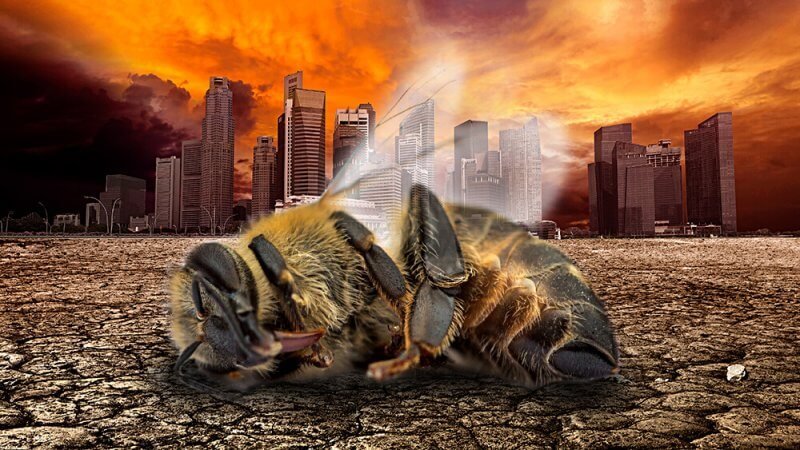Substitute the word “science” for “law” and the same would apply to many environmental advocacy groups and even some politicians campaigning to ban various pesticides on the grounds that they’re contributing to a dangerous collapse in our pollinator population.
With neither the facts nor the science on their side, they’ve been doing a lot of table pounding lately.
As I and others have detailed in the Genetic Literacy Project and as other news organizations such as the Washington Post and Slate have outlined, the pollinator-collapse narrative has been relentless and mostly wrong for more than seven years now.
It germinated with Colony Collapse Disorder that began in 2006 and lasted for a few years—a freaky die off of bees that killed almost a quarter of the US honey bee population, but its cause remains unknown. Versions of CCD have been occurring periodically for hundreds of years, according to entomologists.
This was a worrisome event in part because it exacerbated a trend, first evidenced in the 1980s, when the Varroa destructor mite invaded the North American and European bee populations, seeding a corrosive health problem among the pollinators. Today, almost all entomologists are convinced that the ongoing bee health crisis is primarily driven by the nasty Varroa. Weakened honey bees, trucked around the country as livestock, face any number of health stressors along with Varroa, including the use of miticides used to control the invasive mite, changing weather and land and the use of some farm chemicals, which may lower the honeybee’s ability to fight off disease.
Rise of the Bee-pocalypse
Still, the ‘bee crisis’ flew under the radar until 2012, when advocacy groups jumped in to provide an apocalyptic narrative after a severe winter led to a sharp, and as it turned out temporary, rise in overwinter bee deaths.
Colony loss numbers jumped in 2006 when CCD hit but have been steady and even improving since.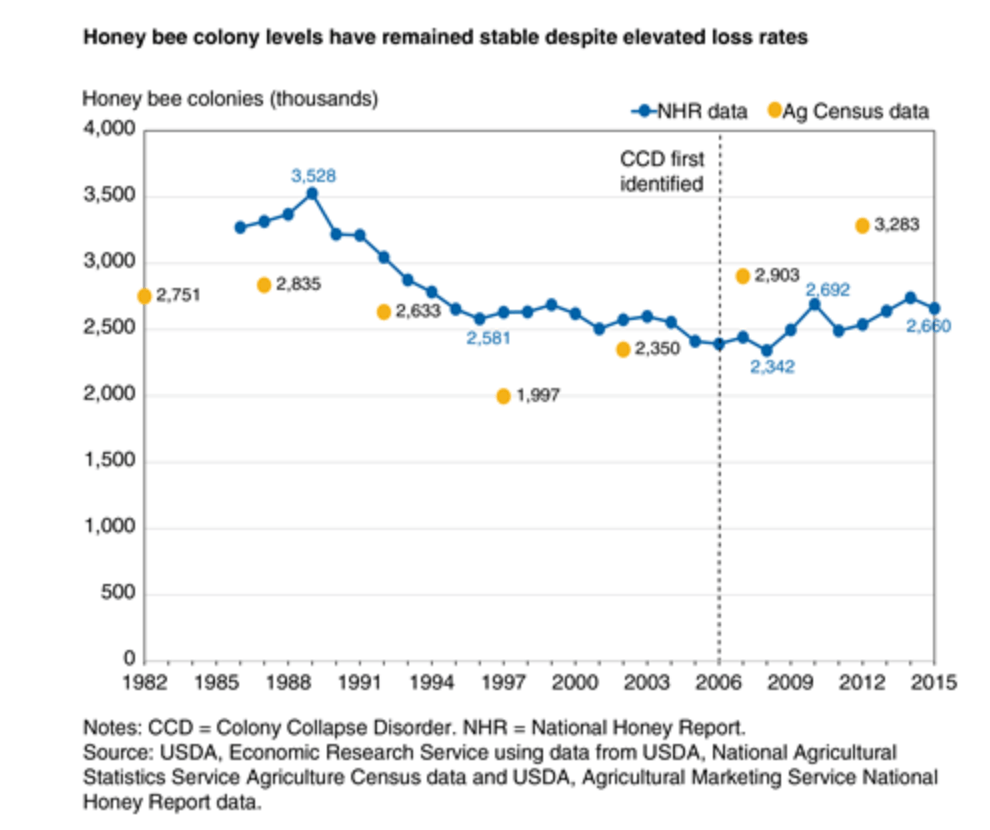
The alarm bells came with a spin, as advocacy groups blamed a class of pesticides known as neonicotinoids, which were introduced in the 1990s, well after the Varroa mite invasion infected hives and started the decline. The characterization was apocalyptic, with some activist claiming that neonics were driving honey bees to extinction.
The “bee-pocalypse,” as it was dubbed, became front page news – most famously in Time magazine’s cover story titled “A World Without Bees.” The claim that neonics were at fault was originally given some credence by laboratory experiments, most of which over-dosed individual bees with neonics, which is not the way bees naturally encounter the insecticide, which is mostly applied by coating seeds.
In the lab evaluations, which are not considered state of the art—field evaluations replicate real-world conditions far better—honeybee mortality did increase. But that was also true of all the insecticides tested; after all, they are designed to kill harmful pests. Neonics are actually far safer than the pesticides they replaced, mostly organophosphates (which are synthetic) and pyrethrins (which are natural and used by organic farmers), both of which are carcinogenic to humans and harmful to beneficial insects. A study by researchers at the Department of Agriculture and Mississippi State University showed that neonics are far from the “most bee-deadly” pesticide as many advocacy groups claim, particularly when their impact is observed under field-realistic conditions (i.e., the way farmers would actually apply the pesticide).
The media firestorm touched off a panic in policy circles, mostly targeting neonics. Emergency regulatory reviews were launched in the EU, US and Canada before. But as the media noise level increased, the actual statistics on bee hive numbers were actually telling a different story. The stats on honeybee populations, which are kept by most national governments and can easily be found on publicly accessible websites kept by FAO, StatsCanada and the USDA, among other groups, showed that far from declining, honeybee populations have been rising on every continent (except Antarctica) since neonics entered the market in the mid-1990s.
As the “science” supporting the bee-pocalypse came under scrutiny, the ‘world pollinator crisis’ narrative began to fray. Not only was it revealed that the initial experiments had severely overdosed the bees, but increasing numbers of high-quality field studies – which test how bees are actually affected under realistic conditions – found that bees can successfully forage on neonic-treated crops without noticeable harm. Not surprisingly, these tests comported with real-world evidence in places such as Australia, where there is no Varroa mite crisis, and in Western Canada, where thriving beekeeping operations transport their hives into the middle of the region’s massive neonic-treated canola fields to harvest their nutritious pollen.
The honey bee-pocalypse narrative was eventually dealt a final blow by the US EPA’s preliminary assessment of neonics, published in 2017. While still being finalized, EPA’s analysis has clearly found that most uses, including seed treatments, “do not pose significant risks to bee colonies.” Soon thereafter, Canada’s PMRA issued a similar finding.
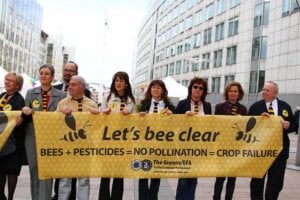
But by that time, Europe had ceded the science to hysteria. The EU’s precautionary ban on neonics, so often cited by activists as proof of a crisis, actually supports the conclusion that we are not in crisis as well, although in a somewhat backhanded way. As I have previously explained, the EU regulators – under intense political pressure to ban the chemicals – were forced to rig the review process to arbitrarily exclude field tests that clearly showed neonics have a minimal environmental impact. Regulators then cited “data gaps” in their scientific assessment – in other words, the evidence they had excluded – to rationalize a “precautionary” ban.
What about a wild bee crisis?
Those determined to keep the crisis narrative alive were hardly deterred. Deprived of both facts and science to argue their case, many advocacy groups simply pounded the table by shifting their crisis argument dramatically. For example, in 2016, the Sierra Club (while requesting donations), hyped the honey bee crisis to no end:
Bees had a devastating year. 44% of colonies killed…and Bayer and Syngenta are still flooding your land with bee-killing toxic ‘neonic’ pesticides—now among the most widely used crop sprays in the country.
But more recently, in 2018, the same organization posted a different message on its blog. Honeybees, the Sierra Club grudgingly acknowledged, were not threatened.
Honeybees are at no risk of dying off. While diseases, parasites and other threats are certainly real problems for beekeepers, the total number of managed honeybees worldwide has risen 45% over the last half century.
Forget honeybees, the Sierra Club said, the problem is now wild bees, or more generally, all insect pollinators, which are facing extinction due to agricultural pesticides of all types (though neonics, they insisted, were especially bad). “Native bees,” the organization, wrote on its website, “of which there are over 20,000 species varying in size, shape, and color—are experiencing incredible losses.”
But is that claim any more credible than the ‘cry wolf’ statements issuing from the Sierra Club just two years earlier? As I have written here and here, these more recent claims are harder to evaluate because there are literally thousands of wild bee species and somewhere between one and 30 million insect species. In neither case do we even know how many, let alone how many individuals there are in each.
The most famous attempt to end-run the species estimation problem is the recent Sanchez-Bayo study claiming to show a world-wide “insect apocalypse.” At least that’s how the press initially billed it, with the New York Times portentiously announcing “The Insect Apocalypse is Here.” But the research was barely published before the scientific community challenged the results (here, here, here).
The stability of the bumble bee population is hotly debated. Those pushing the decline narrative generally rely on observed regional declines in a handful of species, such as the rusty patched bumblebee, which was added to the Endangered Species list in 2017.
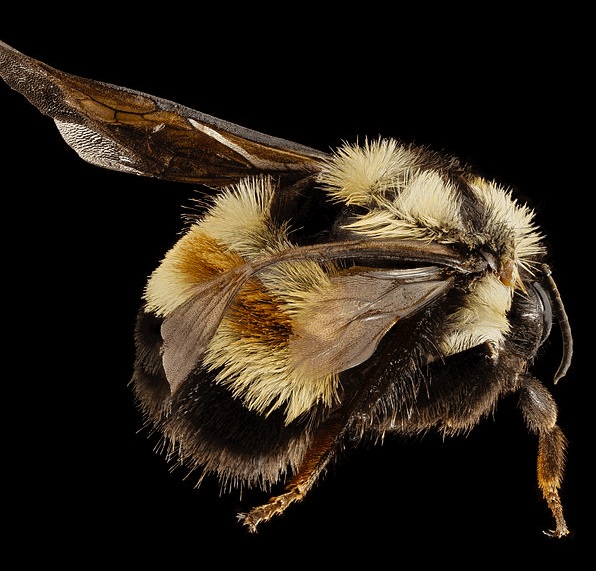
But this narrative frequently ignores well-known evidence that many wild bee species are thriving. Even more dissonant to the wild bee decline story is the fact that the wild bees species that are documented as thriving are precisely the ones that are known to pollinate agricultural crops, and so come into the most direct contact with pesticides.
The most comprehensive work in this field has been conducted by David Kleijn and his team at Wageningen University in the Netherlands. A global survey published in Nature in 2015, conducted over three years by 58 researchers across five continents, found that just 2 percent of bee species account for some 80 percent of crop visits. As the researchers note in their summary,
Across crops, years and biogeographical regions, crop-visiting wild bee communities are dominated by a small number of common species, and threatened species are rarely observed on crops.
One of the foremost wild bee experts in the US, Sam Droege with the US Geological Survey, who is conducting the first ever census of wild bee species in North America, said he believes wild bees are generally “doing fine.” Yes, they face challenges, he says, which stem mostly from loss of habitat, not pesticides, as most species live far away from farms and most don’t pollinate crops.
A 2013 study published in the Proceedings of the National Academy of Sciences analyzed US native bee populations over a 140-year period. Of the 187 native species analyzed individually, only three declined steeply – all among the genus Bombus, or bumblebees.
It’s well established that disease spread from managed bumblebees imported to pollinate commercial greenhouse crops are responsible for many of the specific species declines. This is even true of the activist poster child, the rusty patched bumblebee, which appears prominently in the International Union for Conservation of Nature (IUCN) “Red List,” often cited in activist campaigns. As even the Sierra Club notes:
…. diseases from commercial hives can be transferred to wild species when the populations feed from the same flowers. As with other intensively farmed animals, overcrowding and homogenous diets have increased the level of pathogens and parasites in managed honeybee colonies. Researchers have found elevated disease rates in wild bees living near greenhouses that use managed bees in Canada, Ireland and England. According to the International Union for Conservation of Nature, the rusty patched bumblebee, which was listed as endangered in early 2017 after declining more than 90 percent over the last decade, may owe that disappearance to diseases spread by commercial bees.
Another factor that scientists are just beginning to appreciate is that the large increase in managed honeybees for crop pollination services may be playing a role in wild bee declines. Challenging the accepted crisis wisdom of just a few years ago, it’s now widely acknowledged that honeybee populations are rising. Moreover, it may indeed be competition from increased numbers of honeybees for forage on the same flowers that is depressing the few—including some four species of bumblebees identified by the Sierra Club— wild bees known to be in decline.
Global food supplies aren’t threatened
So, once again, with neither the facts nor the science to back them up, advocacy groups have pulled a switcheroo and are again pounding the table. As they once claimed with honeybees, they now claim that the loss of wild bees and other insect pollinators imperils our food supply. A popular meme on this topic is the oft-cited statistic, which appears in the recent UN IPBES report on biodiversity, that “more than 75 per cent of global food crop types, including fruits and vegetables and some of the most important cash crops such as coffee, cocoa and almonds, rely on animal pollination.”
There’s a sleight of hand here. Most people (including most journalists) miss or gloss over the important point that this is 75 percent of crop types, or varieties, not 75 percent of all crop production. In fact, 60 percent of agricultural production comes from crops that do not rely on animal pollination, including cereals and root crops. As the GLP noted in its analysis, only about 7 percent of crop output is threatened by pollinator declines—not a welcomed percentage, but far from an apocalypse.
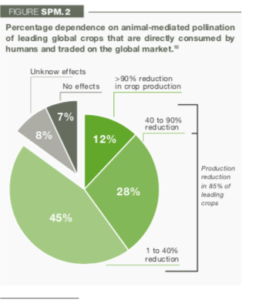
And the word “rely” seems almost purposefully misleading. More accurately, most of these crops receive some marginal boost in yield from pollination. Few actually “rely” on it. A UN IPBES report on pollinators published in 2018 actually breaks this down in a convenient pie graph.
Many of these facts are ignored by advocacy groups sharpening their axes, and they’re generally lost on the “if it bleeds it leads” media, which consistently play up catastrophe scenarios of crashing pollinator communities and food supplies. Unfortunately, many scientists willingly go along. Some are activists themselves; others hope to elevate the significance of their findings to garner media attention and supercharge grant proposals.
Scientists play the catastrophe game
Two recent examples come from researchers studying wild bee declines in Ontario and New Hampshire, who leveraged their modest findings with scary-sounding quotes clearly designed to feed into the new “wild-bee apocalypse” scenario.
The Canadian Broadcasting Company report on the Ontario study, conducted by researchers at York University, was headlined, “Canadian researchers warn of ‘cascading impacts’ as bumblebee species decline.” Lead author Lawrence Packer warned that the “entire ecosystem” was in danger. In fact, the study looked at only one bumblebee species, Bombus pensylvanicus, and only in Ontario, using “citizen science” and notoriously misleading “museum records,” along with their own field research, to assess its decline.
The New Hampshire study got a similar headline by the AP, which was carried in the Washington Post and other leading publications: “Wild bee species critical to pollination on the decline.” Once again relying on museum insect collections, this time going back 125 years, the researchers found declines in 14 of the 119 New England species they studied. That’s a little less than 12 percent. Nevertheless, lead researcher Sandra Rehan had her talking points ready for her AP interview and was perfectly on message: “Because these species are major players in crop pollination, it raises concerns about compromising the production of key crops and the food supply in general.”
The article focused on Greg Burtt, of Burtt’s Apple Orchard in Cabot, Vermont, who said he relies heavily on wild pollinators to produce crops. His 10 acre, 9,000-tree orchard, however, has been around for 10 years and didn’t report any difficulties in the article.
Yields increasing for pollinator dependent crops
Interestingly, given all the catastrophizing about ongoing wild pollinator declines and the disastrous effects facing food production, no one has thought to look at the statistics to gauge just how “disastrous” it really is. As with honeybee hive numbers, crop data is extensively recorded in Canada by StatsCanada and in the US by the states and by the USDA.
So, we at GLP thought we would do it. Below, are graphs of crop yields, which we had calculated by dividing overall production by number of acres producing the crop. As is noted, in each case we’ve chosen only those crops that are most dependent on wild bee and honeybee pollination, as many crops use both.
We start with Ontario and New England, then chose some representative crops from across the US. Clearly, a multitude of factors influence crop yields, especially weather. So, there will be fluctuations, sometimes dramatic ones, in all historical yield data. But as is clear, the general trend for pollinator sensitive crops is either stability or increases in almost all cases. For the few exceptions where we found declines in yield, the reasons, which have nothing to do with pollination, are noted.
Ontario: Crops for which pollinators have great influence or are important for commercial yields
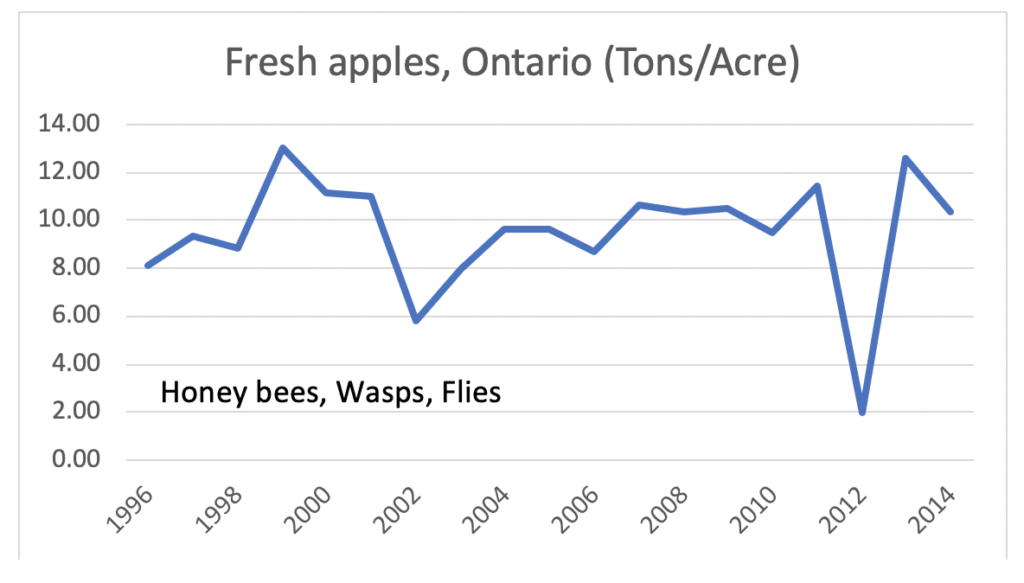
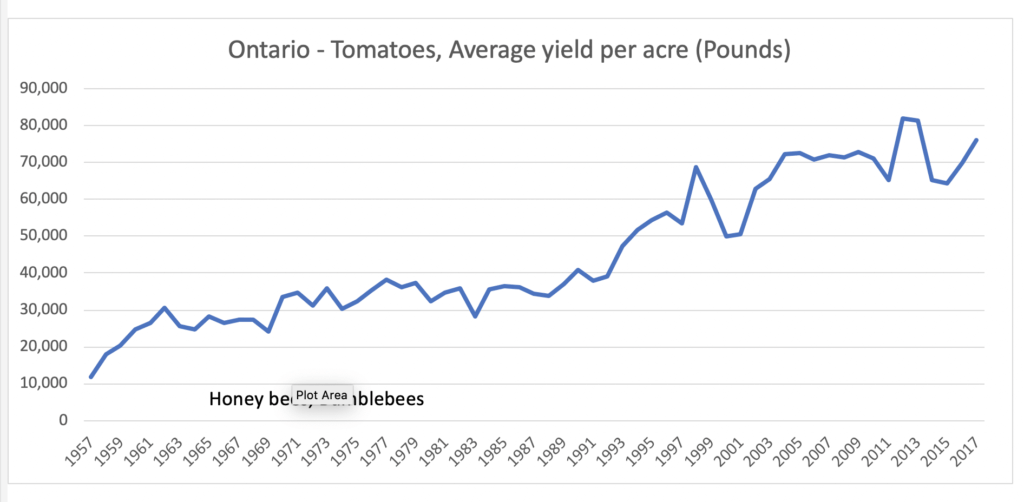
New England: Crops that are greatly influenced by pollination or for which pollination is necessary to maximize commercial yields.
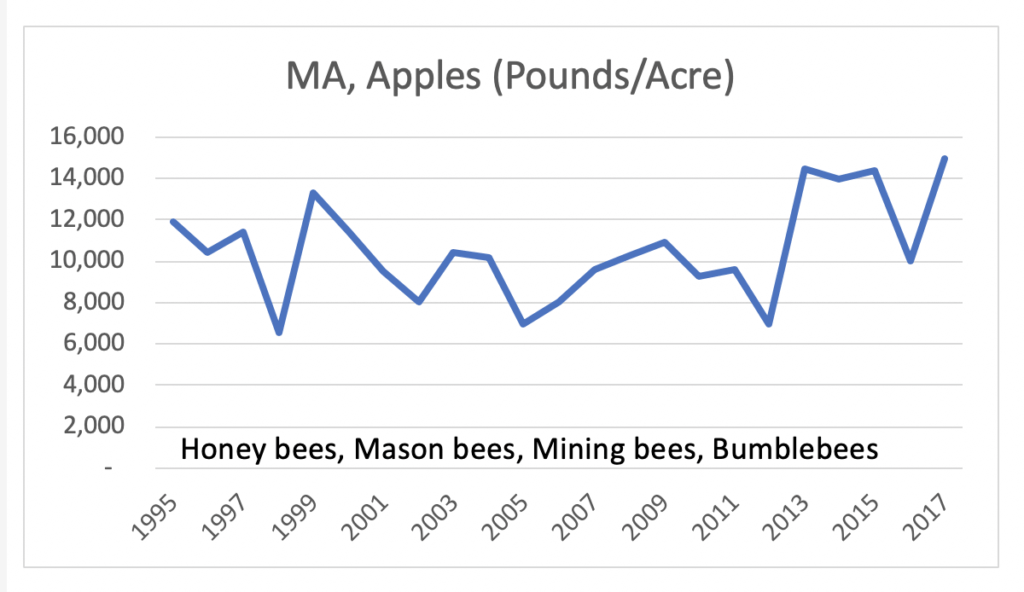
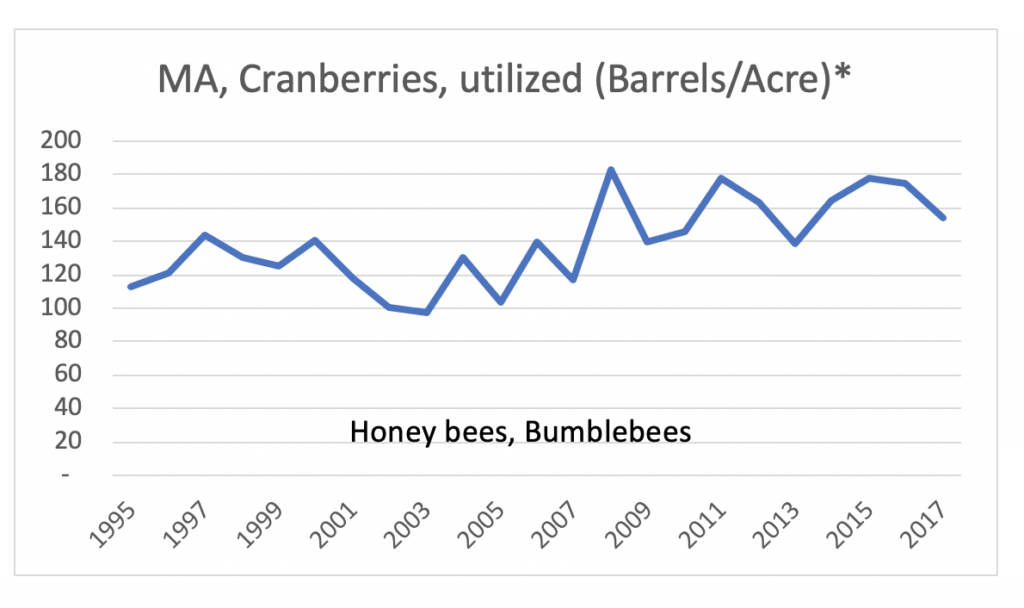


We also looked at a number of crops grown in multiple states across the US. The trend in almost every case is either stable or rising. In the few cases that showed a slight decline, we explain the extenuating circumstances—which have nothing to do with pollinator ‘declines.’
US: Crops for which pollination is essential.
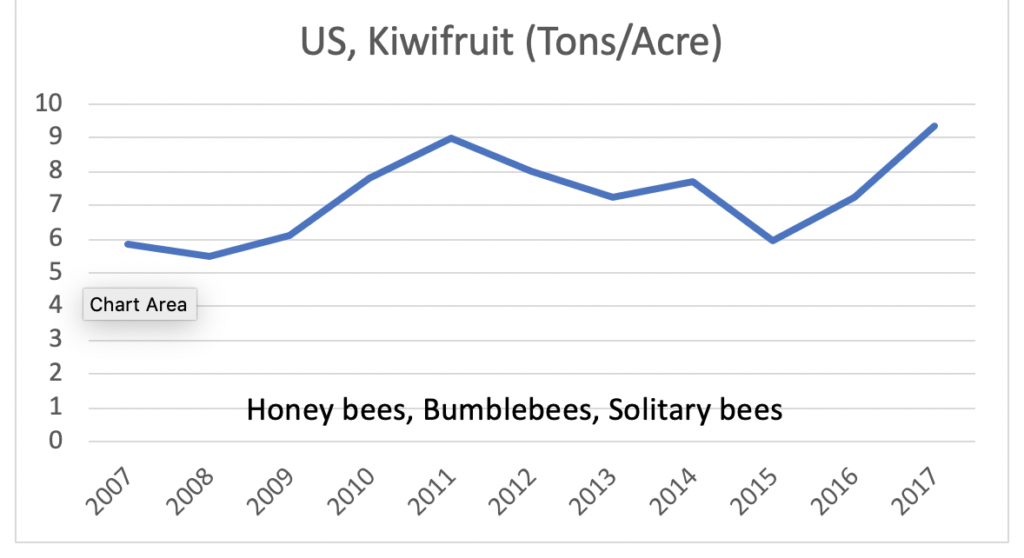
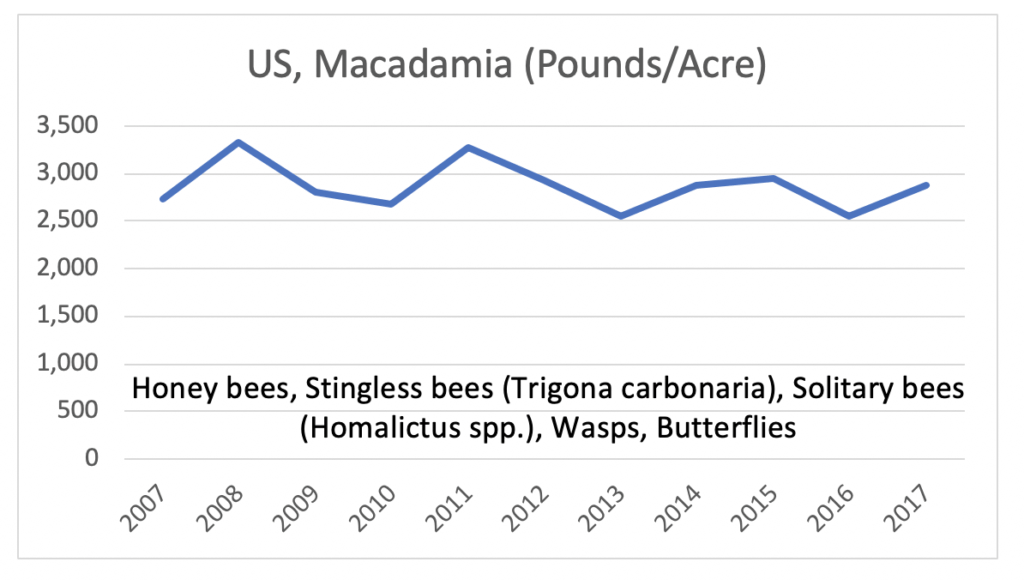
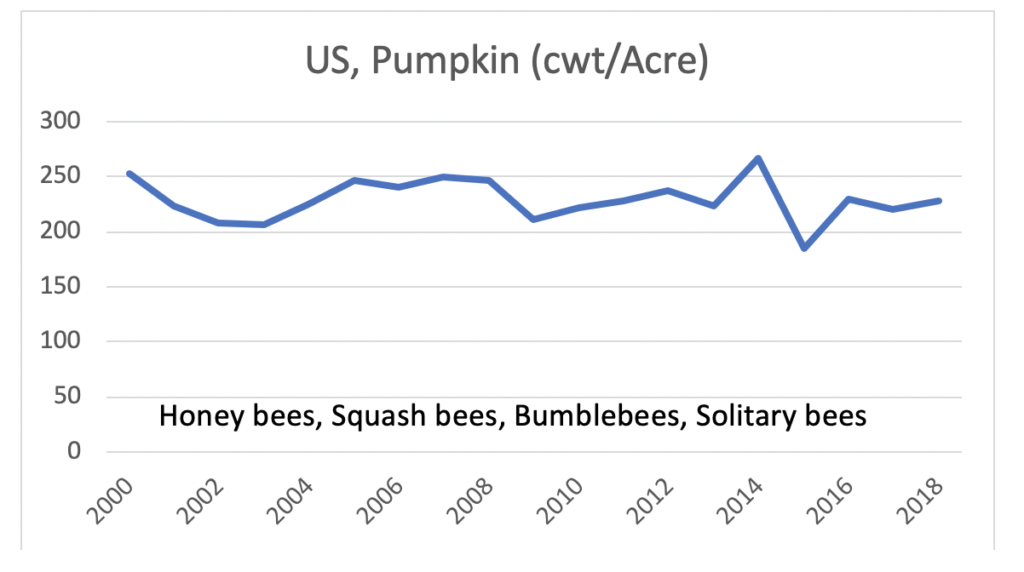
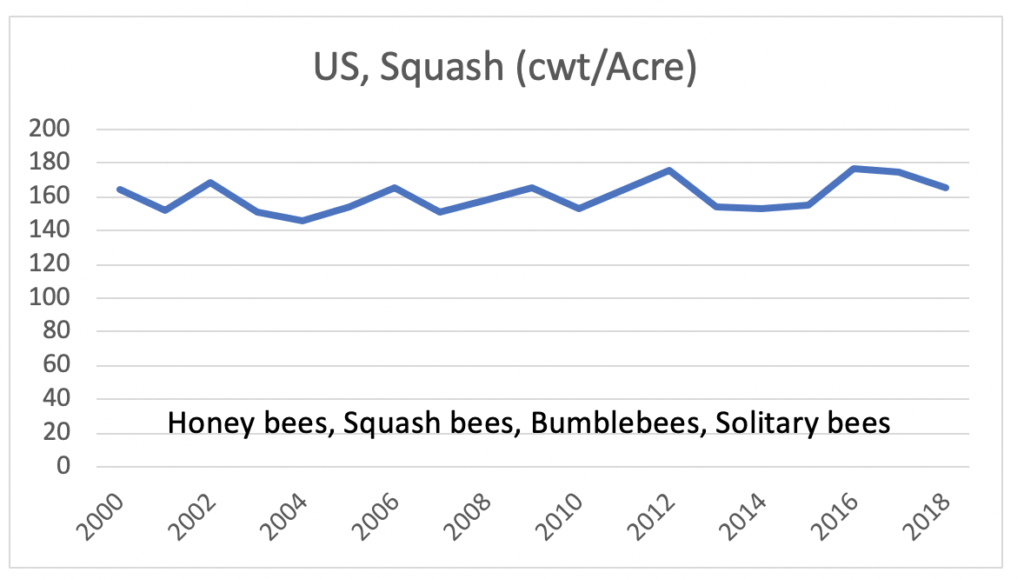
US: Crops for which pollinators have great influence
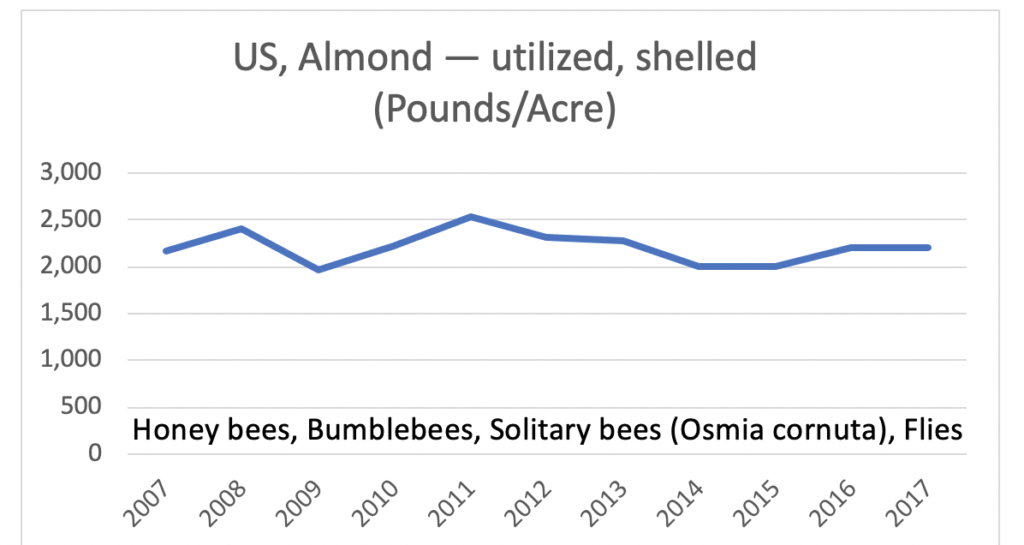

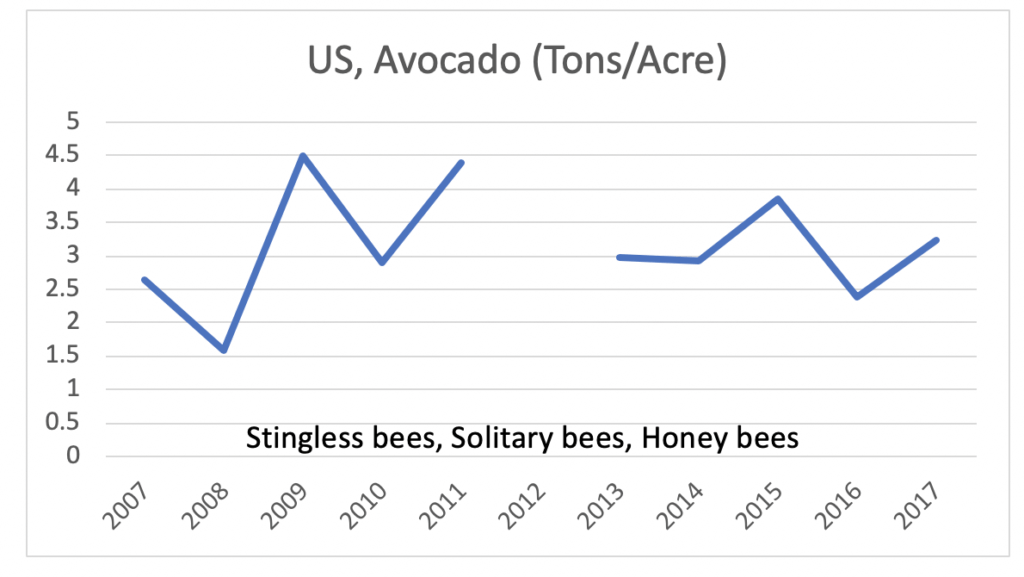
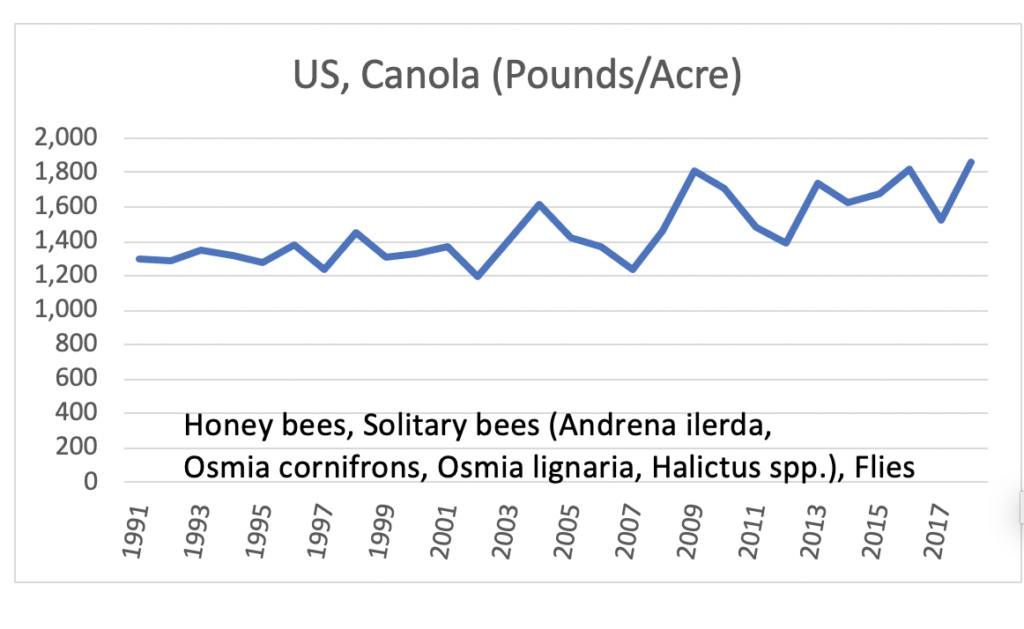 [Apricots need adequate chilling during the winter and require warm and dry weather during bloom time (early-February and mid-March) and throughout summer. As the San Joaquin Valley produces the majority of the California crop (and the state produces 85-95% of US apricots), weather in a handful of counties strongly affect overall US yields. Because of climate variation, winters in the Central Valley have not had adequate chill for the crops in recent years (particularly 2012-13 through 2017-18), reducing yields. The winters of 2013-2014 and 2014-2015 in California were the hottest on record.]
[Apricots need adequate chilling during the winter and require warm and dry weather during bloom time (early-February and mid-March) and throughout summer. As the San Joaquin Valley produces the majority of the California crop (and the state produces 85-95% of US apricots), weather in a handful of counties strongly affect overall US yields. Because of climate variation, winters in the Central Valley have not had adequate chill for the crops in recent years (particularly 2012-13 through 2017-18), reducing yields. The winters of 2013-2014 and 2014-2015 in California were the hottest on record.]
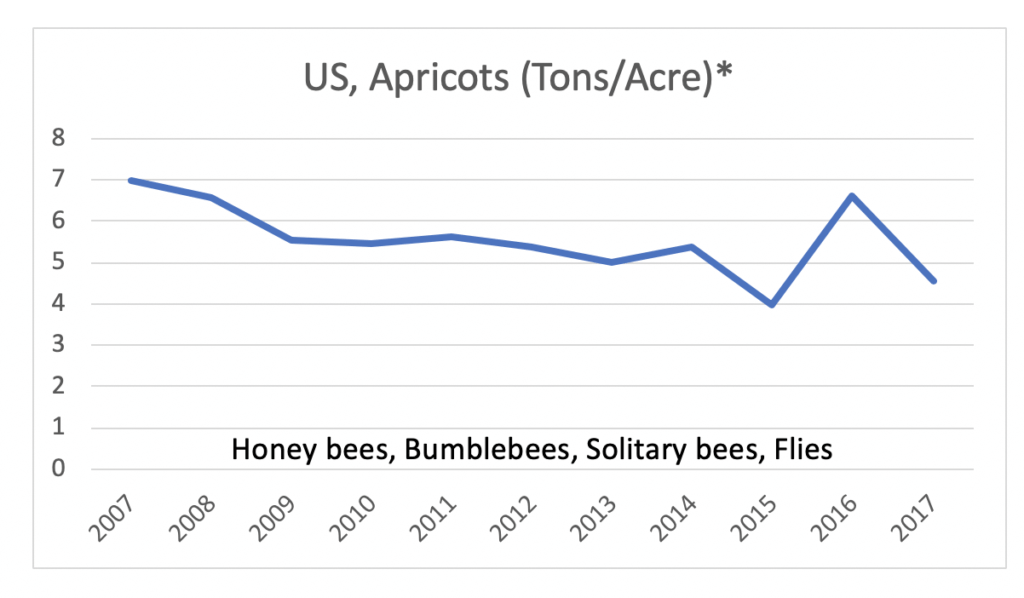

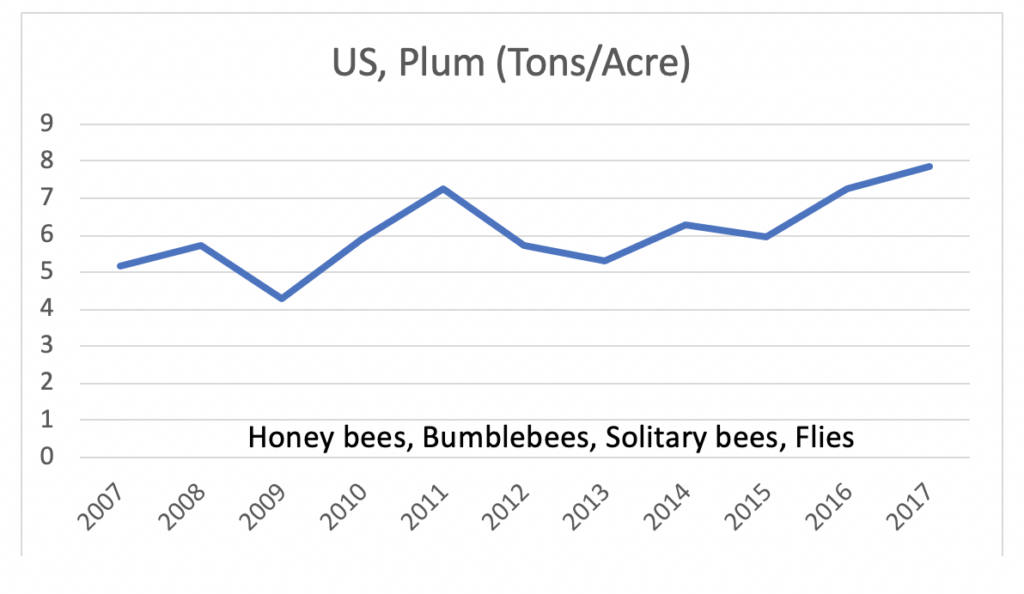
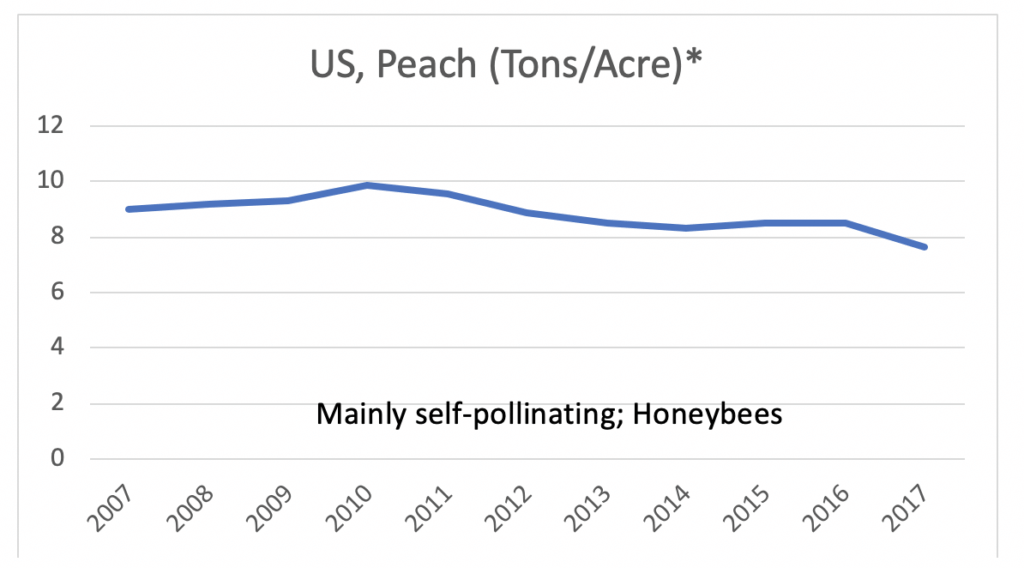
These states not only produce lower yields, they are much more sensitive to extreme weather. Warm winters and early spring frosts can destroy the crop. For example, a freeze in March 2017 destroyed 90% of South Carolina’s peach crop and a late winter freeze in Georgia in 2018 destroyed approximately half of that state’s crop.]
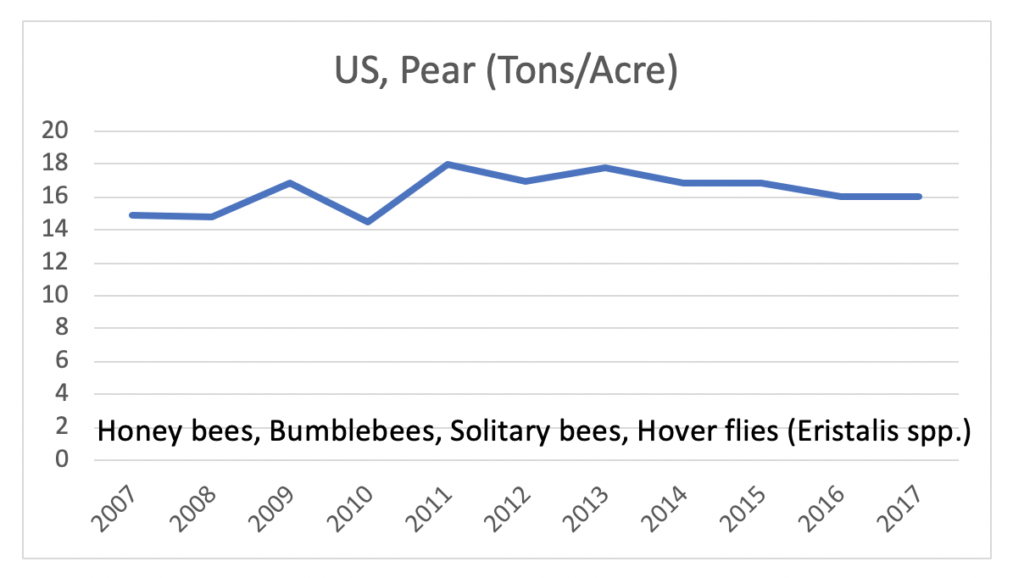

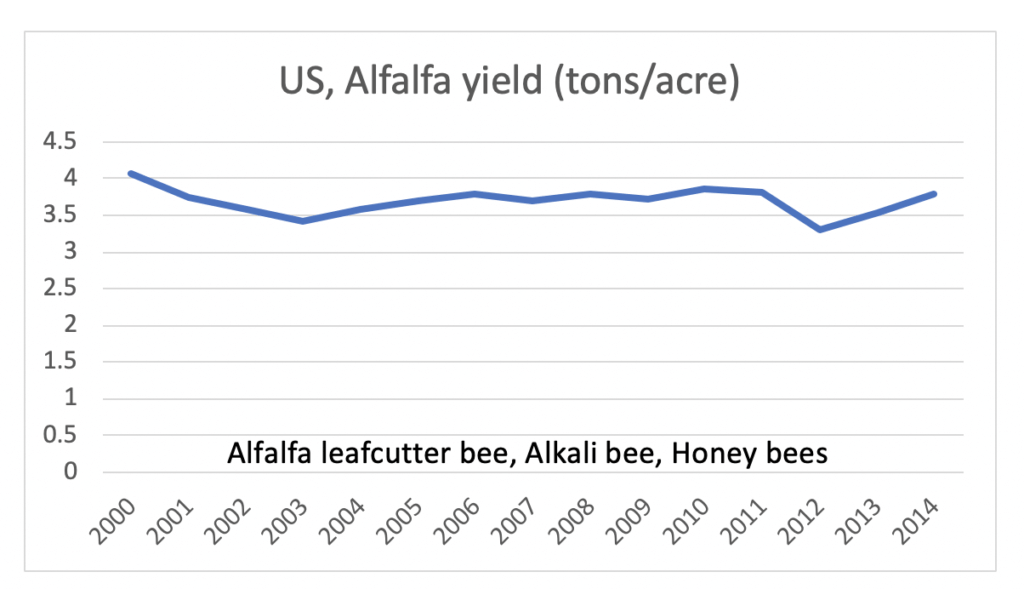
As John Adams is alleged to have said, ‘facts are stubborn things.’ We can’t be simultaneously in the midst of a pollinator crisis threatening our ability to grow food and see continually rising yield productivity among those crops most sensitive to pollination.
With these claims of an impending wild bee catastrophe, as in the case of the original honeybee-pocalypse claims, few of the journalists, activists, scientists or biodiversity experts who regularly sound this ecological alarm have reviewed the facts in context. Advocacy groups consistently extrapolate from the declines of a handful of wild bee species (out of the thousands that we know exist), to claim that we are in the midst of a worldwide crisis. But just as with the ‘honey bee-mageddon, we are not.
Let’s be direct here: the real reason many advocacy groups stir the crisis pot on pollinators is to embolden their attacks on the use of pesticides, which farmers utilize to manage harmful insect infestations. Pollinators clearly face complex health challenges but simplistic diagnoses and selective bans on comparatively safe pesticides, if enacted, are likely in this case to lead to even worse problems. In other words, as well meaning as they may be, and there is no reason to think they do not believe the narrative they promote, some prominent bee-protecting advocacy groups are directly endangering bees and our food system.
With neither the facts nor science on their side, the catastrophists continue to pound the table. Those of us who actually care about science and fact, however, might note the irony here: It is precisely the pesticides which the catastrophists are urging us to ban that, along with the many other tools in the modern farmer’s kit, have enabled us grow more of these nutritious foods, at lower prices, than ever before in human history.
There is no pollinator-pocalypse. Eat your fruits and veggies. They’re good for you.
Jon Entine is executive director of the Genetic Literacy Project. BIO. Follow him on Twitter @JonEntine

